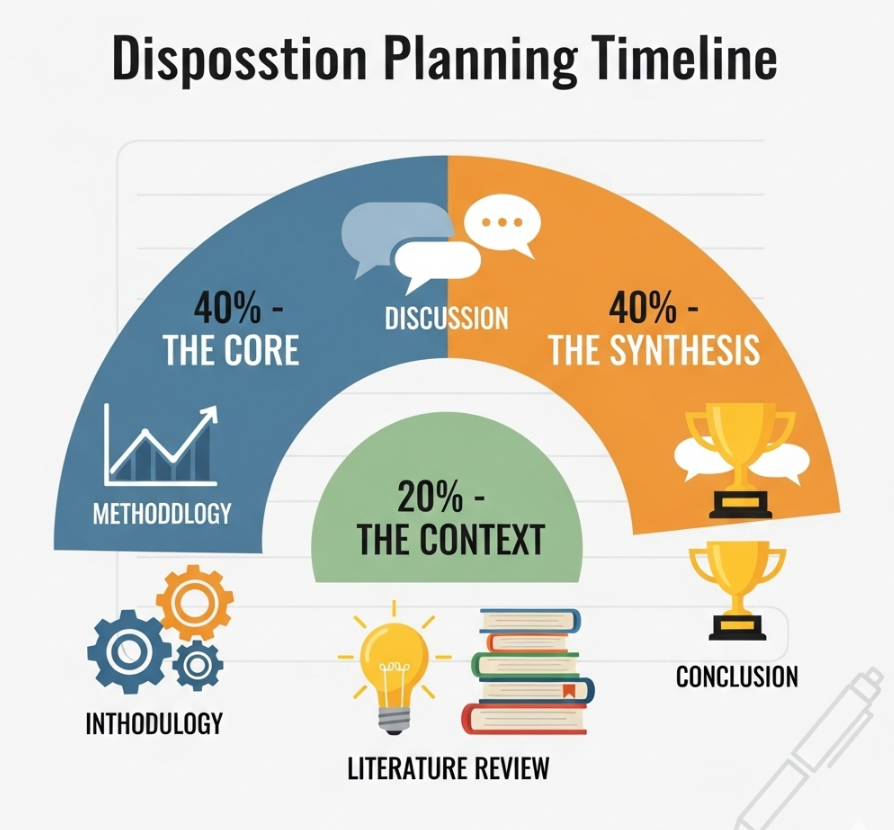A dissertation is a marathon, not a sprint.
The sheer scale of the project can feel overwhelming, and without a clear plan,
it’s easy to get lost in a cycle of procrastination and burnout. The secret to
successfully completing a thesis is not just hard work; it's smart planning.
This guide provides a strategic framework
for mapping out your chapters, allocating your time, and, most importantly,
managing your intellectual energy to get you across the finish line.

The Universal Blueprint: A Standard
Thesis Structure
While disciplines vary, most dissertations
in the STEM and social sciences follow a conventional structure. Understanding
the function of each chapter is the first step in planning your work.
- Chapter 1: Introduction: What is
the problem and why does it matter? This chapter sets the stage, outlines
your research questions, and provides a roadmap for the rest of the
thesis.
- Chapter 2: Literature Review: What
is already known about this problem? Here, you synthesize existing
research to identify the "gap" that your work will fill.
- Chapter 3: Methodology: How did you
try to solve the problem? You detail your research design, data collection
methods, and analytical techniques.
- Chapter 4: Results: What did you
find? This chapter presents the raw findings of your research in a clear,
objective manner, often using tables and figures.
- Chapter 5: Discussion: What does it
all mean? Here, you interpret your results, connect them back to the
literature, discuss the implications, and acknowledge the limitations of
your study.
- Chapter 6: Conclusion: What is your
final answer and contribution? This chapter summarizes your key findings
and states the original contribution your thesis makes to the field.
Strategic Time Allocation: A Practical
Framework
It is a common mistake to assume each
chapter will take an equal amount of time. A more effective approach is to
allocate your effort based on the type of work each chapter requires.
Consider this framework:
- 40% of Your Time on the "Core" Chapters (Methodology
& Results): These chapters are the
empirical heart of your thesis. The work here involves designing
experiments, collecting data, and performing the primary analysis. This is
often the most time-consuming and labor-intensive phase.
- 20% of Your Time on the "Context" Chapters
(Introduction & Literature Review): This
phase is research-intensive but involves synthesizing existing knowledge.
Much of this work can be done early in your candidature.
- 40% of Your Time on the "Synthesis & Polishing"
Chapters (Discussion & Conclusion): This
is the most intellectually demanding phase. The Discussion chapter
requires deep critical thinking to connect your findings to your field.
This block of time should also include final revisions, formatting,
writing the abstract, and proofreading the entire document.
A Phased Approach to Writing Your
Dissertation
Instead of writing sequentially from
Chapter 1 to Chapter 6, consider a more strategic, non-linear approach.
Phase 1: The Foundation (The first ~50%
of your writing timeline)
- Goal: Build the empirical backbone
of your thesis.
- Action: Start by writing your Methodology
chapter. This clarifies your plan. As you collect data, immediately begin
writing the Results chapter. At the same time, you should be
drafting your Literature Review. By the end of this phase, you
should have a complete draft of these core sections.
Phase 2: The Analysis and Argument (The
next ~30% of your timeline)
- Goal: Make sense of your findings
and articulate your contribution.
- Action: With your results clearly
written, immediately move to the Discussion chapter. This is where
you interpret your findings and build your central argument. This is often
the most challenging chapter to write, so tackling it when your core data
is fresh is crucial.
Phase 3: The Framing and Finalizing (The
final ~20% of your timeline)
- Goal: Package your research and
polish the final product.
- Action: Now, write the Introduction.
It may seem counterintuitive, but it's much easier to introduce your work
once you have a complete understanding of your results and discussion.
Next, write the Conclusion, summarizing the journey and
highlighting your contribution. This final phase is dedicated to extensive
editing, proofreading, checking references, and ensuring every detail is
perfect.
Energy Management: Working Smarter, Not
Harder
- Match Tasks to Your Energy Levels:
Use your high-energy, high-focus periods for difficult tasks like data
analysis or writing the Discussion. Use your low-energy periods for more
mechanical tasks like formatting references or resizing figures.
- Set Process-Based Goals: Instead of
an overwhelming goal like "Finish Chapter 4," set smaller,
process-based goals like "Write for 90 minutes" or "Analyze
two datasets." This builds momentum and reduces anxiety.
- Plan for the Unexpected: No
research plan is perfect. Build buffer time into your schedule to account
for failed experiments, unexpected results, or personal emergencies.
Conclusion
A dissertation is the culmination of years
of work, and its successful completion relies on a well-thought-out plan. By
strategically structuring your chapters, allocating your time based on the
demands of each section, and managing your energy effectively, you can turn an
intimidating mountain into a series of manageable hills.


